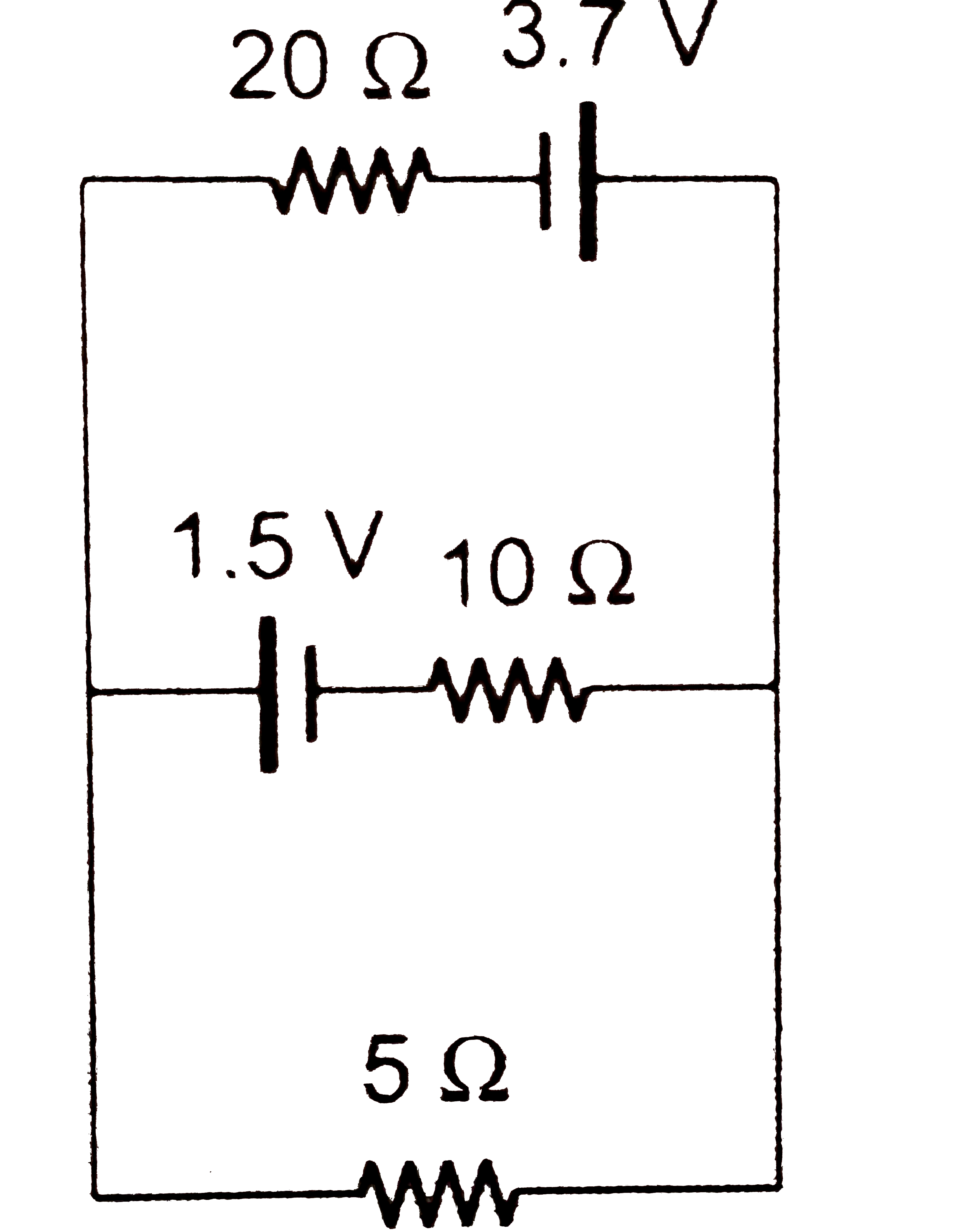(i) In fig. 6.7, find the potential difference berween the points A and B.
(ii) Now we wish to measure this potential difference by using a voltemter of resistance 2kΩ. Find the reading of the voltumeter and percentage error.
(ii) Solve part (ii) if the voltumter were of resistance 20kΩ. What conculsion do you draw from the results you get in the above parts?

As both the resistances are same, 40V will be divided equally among both the resistances. Hence, the potential difference across A and B is 20V.
(ii) Equivalent resistance of 200Ω and 2kΩ is
R1=200×200200+200=200011Ω

Reading of voltmeter = potential difference across AB
=V1=2000/(11×40)2000/(11+200)=19.05V
Percentage error =20−19.0520×100=4.75%
(iii) In this case
R1200×20,000200+20,000=20,000101Ω
Reading of voltmeter
= potential difference across AB
=V2=20,000/(101×40)20,000/(101+200)=19.90V
Percentage error =20−19.920×100=0.5%
In case (iii), percentage error is less than that in case (ii). It means the more the resistance of the voltmeter, the more accurate the reading.
Topper's Solved these Questions
- ELECTRICAL MEASURING INSTRUMENTSBOOK - CENGAGE PHYSICSCHAPTER - ELECTRICAL MEASURING INSTRUMENTSEXERCISE - Solved Examples
4 Videos
- ELECTRICAL MEASURING INSTRUMENTSBOOK - CENGAGE PHYSICSCHAPTER - ELECTRICAL MEASURING INSTRUMENTSEXERCISE - Exercise 6.1
15 Videos
- ELECTRIC POTENTIALBOOK - CENGAGE PHYSICSCHAPTER - ELECTRIC POTENTIALEXERCISE - DPP 3.5
14 Videos
- ELECTROMAGENTIC INDUCTIONBOOK - CENGAGE PHYSICSCHAPTER - ELECTROMAGENTIC INDUCTIONEXERCISE - QUESTION BANK
40 Videos
Similar Questions
Resistances R1andR2, each 600Ω, are connected in series as shown in figure-3.382. The potential difference between points A and B is 120 V. Find the reading of voltmeter connected between points C and D ifits resistance is 120Ω

View Solution(a) Find the value of i and potential difference across each cell.

(b) Find potential difference between A and B.

( c) In the given circuit,

find
(i) potential difference between terminals 10V cell
(ii) current through 25V cell
(iii) current through 5Ω
(d) Find the current through resistance 5Ω.
 .
.
View Solution(a) What do you understand by the term ''potential difference''?
(b) What is meant by saying that the potential difference between two points is 1 volt?
(c) What is the potential difference between the terminals of a battery if 250 joules of work is required to transfer 20 coulombs of charge from one terminal of battery to the other?
(d) What is a voltmeter? How is a voltmeter connected in the circuit to measure the potential difference between two points. Explain with the help of a diagram.
(e) State whether a voltmeter has a high resistance or a low resistance. Give reason for your answer.
View SolutionAs shown in figure a variable rheostat of 2kΩ is used to control the potential difference across 500 ohm load. (i) If the resistance AB is 500Ω, what is the potential difference across the load ? (ii) If the load is removed, what should be the resistance at BC to get 40 volt btween B and C ?

View Solution(i) The potential difference between two points in an electric circuit is 1 volt. What does it mean? Name a device that helps to measure the potential difference across a conductor.
(ii) Why does the connecting cord of an electric heater not glow while the heating element does?
(iii) Electrical resistivities of some substances at 20∘C are given below:

Answer the following questions using above data:
(a) Among silver and copper, which one is a better conductor? Why?
(b) Which material would you advise to be used in electrical heating devices and why?
View SolutionThe battery of EMF 5V and internal resistance 20Ωis connected with a resistance R1=50Ω and a resistance . A voltmeter of resistance 1000Ω is used to measure the potential difference across R1 .What percentage error is made in the reading.
View Solution(a) Derive a relation between the internal resistance, emf and terminal potential difference of a cell from which current I is drawn. Draw V vs I graph for the cell and explain its significance.
(b) A voltmeter of resistance 988Ω is connected across a cell of emf 2 V and internal resistance 2Ω. Find the potential difference across the voltmeter and also across the terminals of the cell. Estimate the percentage error in the reading of the voltmeter.
View Solution(a) Find the potential difference between A and B

(b) Calculate the current flowing in the circuit and the potential difference across terminals of each cell.

( c) Calculate the potential difference across terminals of each cell.

(d) Calculate the potential difference between A and B

( e) Calculate the current in each resistor and terminal potential difference across each cell.

(f) Calculate potential difference across each cell.

(g) A battery of 6 cells each of emf 2V and internal resistance 0.5Ω is being changed by DC mains of emf 220V by using an external resistance of 10Ω. Calculate.
(i) the charging current
(ii) the potential difference across the battery.
 .
.
View SolutionA cell of emf 2V and internal resistance 0.1Ω supplies a current through a coil of resistance 11.0Ω. The current is being measured by an ammeter whose resistance is 6Ω. What reading does it give ? What is the percentage difference from the actual current, when the meter is not used ?
View Solution(a) A voltmeter with resistance Rv is connected across the terminals of a battery of emf E and internal resistance r. Find the potential difference measured by the voltmeter.
(b) IfE=7.50V and r=0.45Ω, find the minimum value of the voltmeter resistance Rv so that the voltmeter reading is within 1.0% of the emf of the battery. (c) Explain why your answer in part (b) represents a minimum value.
View Solution